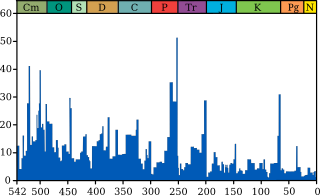The Cambrian–Ordovician extinction event, also known as the Cambrian-Ordovician boundary event,[1] was an extinction event that occurred approximately 485 million years ago (mya) in the Paleozoic era of the early Phanerozoic eon.[2] It was preceded by the less-documented (but probably more extensive) End-Botomian mass extinction around 517 million years ago, and the Dresbachian extinction event about 502 million years ago.
The Cambrian–Ordovician extinction event ended the Cambrian period, and led into the subsequent Ordovician period. It eliminated many brachiopods and conodonts, and severely reduced the number of trilobite species.[1]
Causes
editVolcanic activity, particularly that of large igneous provinces, has been speculated to have been the cause of the environmental crisis.[3] The emplacement of the Namaqualand–Garies dykes in South Africa has been dated to 485 mya, the time at which the Cambrian–Ordovician extinction event occurred, although there remains no unambiguous evidence of a causal relationship between this volcanism and the biotic turnover.[2] Anoxia and changes in sea level have also been proposed as potential causal factors.[1] The middle Cambrian to early Ordovician is characterized by persistent elevated extinction rates that are thought to have been maintained by anoxic conditions. [4] A decrease in the anoxic conditions of the Cambrian, and an increase in euxinic conditions (or an increase in hydrogen sulfide concentrations) of the Early Ordovician are also believed to be an initiator of the Great Ordovician Biodiversification Event. [5]
Effects on life
editTrilobites were among the hardest hit organisms by the extinction. Shallow shelf trilobite faunas were hit particularly hard. Trilobites that inhabited the outer edges of shelf environments and slope environments, on the other hand, were minimally impacted by the event.[1] Many trilobites appear to have been adapted to the anoxic conditions of the Cambrian through symbiosis with the sulfur-oxidizing bacteria.[6]
Controversy
editSoft-body fossils with morphology characteristic of the Cambrian have been uncovered in Morocco, dated 20 million years post-extinction. The 2010 paper by Roy, Orr, Botting, and their collaborators that announced the discovery suggests that Cambrian species persisted into the mid-Paleozoic. They argue that what had been interpreted as a Cambrian-Ordovician extinction is instead an artifact resulting from a gap in the stratigraphic record. Remains of soft-bodied animals prevalent in earlier, exceptional Cambrian fossil beds were only preserved in later, Ordovician deposits in rare places where special conditions promoted fossilization of soft bodies.[7]
See also
edit- End-Botomian mass extinction, circa 517 mya
- Dresbachian extinction event, circa 502 mya
- Geologic time scale
- Furongian, Late or Upper Cambrian period
- Early Ordovician period
References
edit- ^ a b c d Fortey, Richard Alan (6 November 1989). "There are extinctions and extinctions: examples from the Lower Palaeozoic". Philosophical Transactions of the Royal Society B: Biological Sciences. 325 (1228): 327–355. Bibcode:1989RSPTB.325..327F. doi:10.1098/rstb.1989.0092. Retrieved 19 April 2023.
- ^ a b Kingsbury, Cole G.; Klausen, Martin B.; Altermann, Wladyslaw; Ernst, Richard E. (March 2021). "Identification of a new 485 Ma post-orogenic mafic dyke swarm east of the Pan-African Saldania-Gariep Belt of South Africa". Precambrian Research. 354: 106043. Bibcode:2021PreR..35406043K. doi:10.1016/j.precamres.2020.106043. S2CID 233768508. Retrieved 19 April 2023.
- ^ Kravchinsky, Vadim A. (April 2012). "Paleozoic large igneous provinces of Northern Eurasia: Correlation with mass extinction events". Global and Planetary Change. 86–87: 31–36. Bibcode:2012GPC....86...31K. doi:10.1016/j.gloplacha.2012.01.007. Retrieved 19 April 2023.
- ^ Saltzman, Matthew R; Edwards, Cole T; Adrain, Jonathan M; Westrop, Stephen R. "Geology(Boulder)". pubs.geoscienceworld.org. Retrieved 2023-11-08.
- ^ Kozik, Nevin P.; Young, Seth A.; Lindskog, Anders; Ahlberg, Per; Owens, Jeremy D. (May 2023). "Protracted oxygenation across the Cambrian–Ordovician transition: A key initiator of the Great Ordovician Biodiversification Event?". Geobiology. 21 (3): 323–340. doi:10.1111/gbi.12545. ISSN 1472-4677. PMID 36703593. S2CID 256304011.
- ^ John, Douglas L.; Walker, Sally E. (2016-01-01). "Testing symbiotic morphology in trilobites under dysoxic and oxic conditions from Cambrian to Early Ordovician Lagerstätten". Palaeogeography, Palaeoclimatology, Palaeoecology. 441: 704–720. doi:10.1016/j.palaeo.2015.10.007. ISSN 0031-0182.
- ^ Roy, P.V.; Orr, P.J.; Botting, J.P.; Muir, L.A.; Vinther, J.; Lefebvre, B.; el Hariri, K. & Briggs, D.E.G. (2010). "Ordovician faunas of Burgess Shale type". Nature. 465 (7295): 215–218. Bibcode:2010Natur.465..215V. doi:10.1038/nature09038. PMID 20463737. S2CID 4313285.
Further reading
edit- Gradstein, Felix, James Ogg, and Alan Smith, eds., 2004. A Geologic Time Scale 2004 (Cambridge University Press)
- Hallam, Anthony and Paul B. Wignall, 1997. Mass extinctions and their aftermath (Oxford University Press)
- Webby, Barry D. and Mary L. Droser, eds., 2004. The Great Ordovician Biodiversification Event (Columbia University Press)
